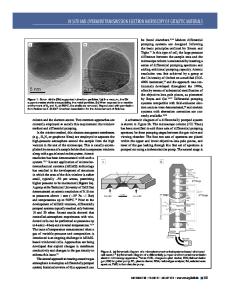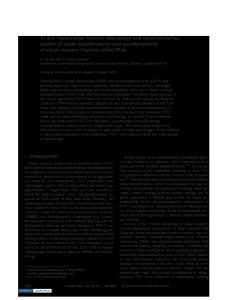In situ transmission electron microscopy studies of electric-field-induced phenomena in ferroelectrics
- PDF / 1,621,680 Bytes
- 13 Pages / 612 x 792 pts (letter) Page_size
- 84 Downloads / 343 Views
Jian-Ku Shang Department of Materials Science and Engineering, University of Illinois at Urbana-Champaign, Urbana, Illinois 61801 (Received 6 January 2005; accepted 25 March 2005)
High electric fields were delivered to specimens during imaging in the transmission electron microscopy (TEM) chamber to reveal details of electric field-induced phenomena in ferroelectric oxides. These include the polarization switching in nanometer-sized ferroelectric domains and the grain boundary cavitation in a commercial lead zirconate titanate (PZT) polycrystalline ceramic, the domain wall fracture in a Pb(Mg1/3Nb2/3)O3–PbTiO3 single crystal, and the transformation of incommensurate modulations in Pb0.99Nb0.02[(Zr1−xSnx)1−yTiy]0.98O3 (PZST100x/ 100y/2) polycrystalline ceramics. In the PZT ceramic, a cavitation process was uncovered for the electric field-induced intergranular fracture. In the ferroelectric single crystal, a preexisting crack was observed to deflect and to follow a 90° domain wall, indicating the presence of severe incompatible piezoelectric strains at the domain wall. In the antiferroelectric PZST ceramics, the electric field-induced antiferroelectric-to-ferroelectric phase transformation was accompanied with the disappearance of incommensurate modulations.
I. INTRODUCTION
Many materials respond to external electric field/ current by changing their microstructures. Transmission electron microscopy (TEM) allows one to examine the microstructure in inorganic materials with spatial and chemical resolutions on the atomic level, so attempts have been made to apply electrical signals to TEM specimens while imaging in the hope of revealing the dynamic processes at the nanometer scale. Although such electrical in situ TEM techniques were demonstrated in as early as 1960s when Blech and Meieran were passing a direct current (dc) electrical current through an Al thin film to observe the electromigration process,1 there are only a handful of publications based on this technique at this time. Most of them are studies on the electromigration in interconnecting lines1–5 and the domain switching in ferroelectrics.6–11 Recently, the application of this technique has been expanded to studies of other phenomena, such as the failure mechanism of solid electrolytes,12 the breakdown of grain boundary conducting barrier,13 and
a)
Address all correspondence to this author. e-mail: [email protected] DOI: 10.1557/JMR.2005.0213 J. Mater. Res., Vol. 20, No. 7, Jul 2005
the mechanical fatigue of metallic thin films.14 The present article focuses on the electric field-induced phenomena in perovskite ferroelectrics. It summarizes our previous contributions to this field15–19 and presents our new findings on the antiferroelectric-to-ferroelectric phase transformation in ceramics with incommensurate modulations. Ferroelectric ceramics have found wide applications in capacitors, transducers, actuators, energy storage devices, and random-access memory due to their unique dielectric, piezoelectric, and ferroelectric properties. In most cases, t
Data Loading...











